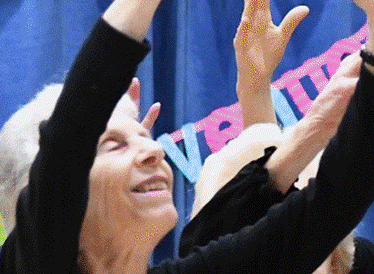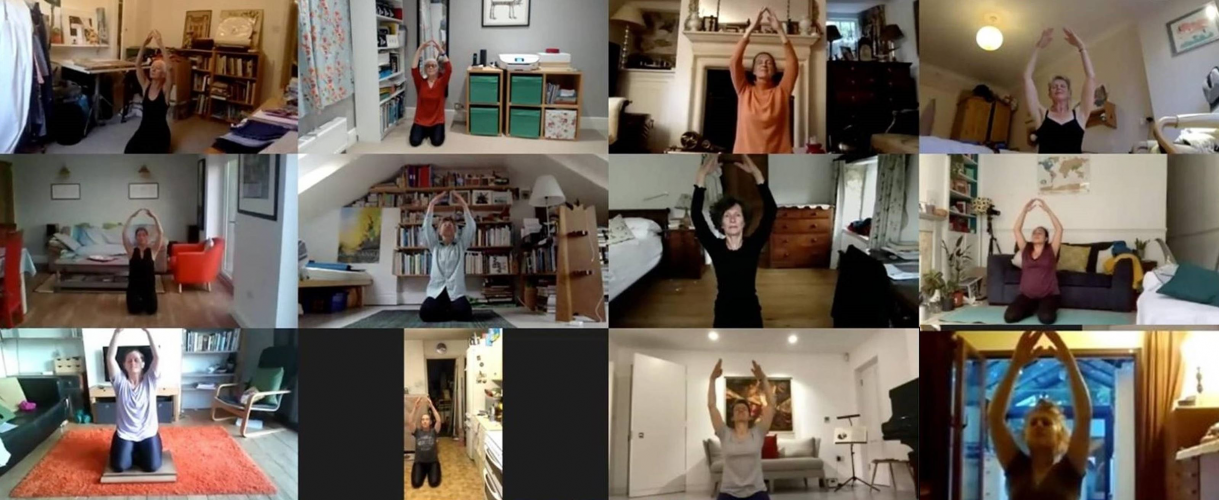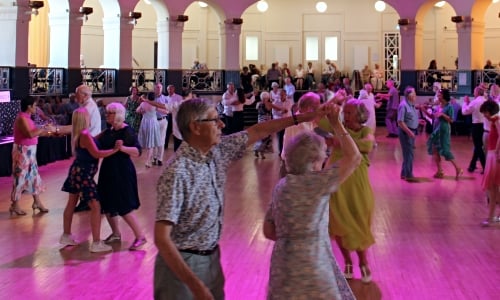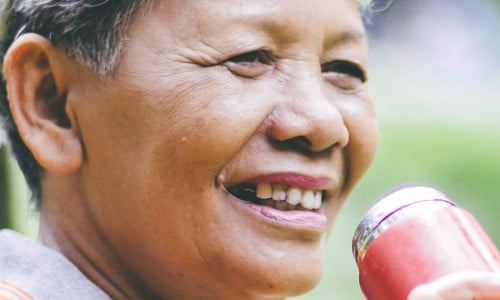We meet four women to discuss their involvement with Chantraine dance, which encourages continuous learning and positivity, so is ideal for older people. Teacher Olexandra and students Jan, Anne and Helen explain how its valuing the individual and unlocking inner resources benefitted them before and during the pandemic.
Chantraine is a unique approach to dance. Named after its creators, Alain and Françoise Chantraine, it focuses on the artistic, educational and human dimensions of dance. Olexandra is a teacher at one of the UK’s two Chantraine schools, in north London, and used to be Chief Officer of Age UK Hackney [now part of Age UK East London] between 2005-2011, so is well attuned to the needs of older people.
Prior to the outbreak of the pandemic, the classes would meet in the comfort of the Sidings Community Centre in Kilburn, but now take place online. Now, as then, the classes are overwhelmingly female. “I think there’s a natural propensity for women to be more open to their inner sense and creativity,” suggests Olexandra. “Nevertheless Chantraine is for everyone, and while some men will enter a class full of women, perhaps a separate men only class is the way to break that barrier to start with.”
There are obvious reasons why Chantraine, also known as ‘The Dance of Expression’, appeals to older people, particularly during a pandemic that’s increased isolation and decreased confidence, as Olexandra explains.

“Dance is good for everyone, but it’s particularly good for older people. It is multimodal, providing the four different types of movement you need for a healthy body: resistance, which strengthens the muscles; aerobic, which supplies oxygen to all parts of the body; balance training, which helps in avoiding falls, or if you do fall to fall 'better'; and stretching and flexibility to maintain physical independence.”
While Chantraine offers all of that, it goes deeper too, engaging the mind and spirit as well as the body, which improves outlooks as well as their health. “It engages the whole person in an experience that’s bigger than dance and looks at life itself.”
Olexandra continues: “You’re never allowed to criticise another person or be negative. You dance and see the best in other people. You’d never look at what you couldn’t do well - you’d look at what you could do well and what you could do better. That same ethos pervades every class, whether you’re 4 or 94.”
Jan
Jan has been attending the classes for 15 years. A passionate folk dancer in her teens and twenties, she lost touch with dance until she was in her fifties, but took it up again to counter the stresses of her busy job at the time. “I felt I needed some time for myself that was really affirming,” she recalls. “I remember saying after my first class, ‘This is what I want to be doing with my Friday afternoons’, and I’ve been going ever since. In fact, I do 2 classes a week now.”
“If I was to describe it in a word it would be ‘joyful’,” explains Jan of the benefits that have kept her so committed. “It’s very welcoming, friendly but also disciplined, with a structure for each class, but the positive is always accentuated. Mistakes are part of it, and welcomed as learning opportunities. There is no adverse criticism at all. If there’s something you can’t do, then the attitude is ‘It’s something you can’t do yet.”
As I get older and I find there are some things I can no longer do, but there’s always a scope to develop a way around those limitations.
“As I get older and I find there are some things I can no longer do - I regret that I can’t jump anymore, for example - but there’s always a scope to develop a way around those limitations, which allows you to still play a full active part in the dance.”
As well as the obvious health benefits the classes bring Jan, she suggests there are deeper ones too. “Dance is part of my response as a human being to the glory and beauty of the world. There’s something in me that’s striving to shape that beauty, bringing out the best that I can be. It’s affirming to every part of my being - psychological, emotional, physical and spiritual.”
Anne
“It was entirely an accident,” says Anne of how she came to be involved with the classes, sometime around 1984.
Anne had been helping with enrollments at an adult education centre, dealing with the hefty queues of applicants, when at one point she found there was a bit of a lull. Looking up, she noticed another woman sat nearby, who suddenly stood up and began a dance routine, resulting in the two women striking up a conversation.
“She explained that she was a Chantraine teacher, for which I’d seen posters in the building,” Anne recalls of their chat. “Before I knew what I was doing, I said ‘I’ve often wondered about that’, so she encouraged me to come along to a class. I explained I wasn’t able to because I had a bad back at the time, but the lady replied, ‘Oh we’ve all got bad things, that doesn’t spoil it’.”
We need all the structure we can get at the moment.
As it turns out, Anne didn’t merely have a bad back - she actually had a slipped disc, but nevertheless went along to the class and kept going, unable to bend sideways or turn but still loving the experience. “And my back got better.”
“It’s an all-encompassing method,” explains Anne of what kept her going, despite a serious injury. “The dance itself takes a bit from ballet, modern dance, jazz and more, and you’re allowed to dance at your own level. You’re encouraged and you want to do your best, but you’re not pushed in a pressured way.”
Anne suggests there are positives and negatives to the classes taking place online, as they’ve had to during the pandemic and lockdown. “We need all the structure we can get at the moment. It’s much easier to exercise with others, but you can’t chat in the same way when you’ve got a screen full of 20 people.”
Helen
Helen was 60 when she found an advert in a magazine offering dance classes for the over 60s. “I was overwhelmed,” she says of the scene that greeted her when she first went along. “There were these lovely, spiritual people dancing in their bare feet.” Helen was clearly taken with her first experience, as she’s still attending 30 years later.
Helen admits to being terrified the first time she had to dance in front of a large group of people, but has grown used to it over the years, particularly enjoying the performances that helped raise money for charitable causes. “I love the music,” she enthuses. “It’s allowed me to release my inhibitions when it comes to dance. I now turn on Classic FM whenever I’m in the kitchen, and I’m dancing straightaway.”
I now turn on Classic FM whenever I’m in the kitchen, and I’m dancing straightaway.
Helen is also keen on the meditative quality of the class, as she’s been something of a “butterfly minded person” from a young age. “I was never very good at concentrating, so the classes definitely help me to concentrate.”
Though the classes now being online has taken some getting used to from a technological standpoint, Helen thinks there are some distinct advantages. “It’s better in a way because you’re dancing but not looking out of the corner of your eye to see what the girl next to you is doing. That way I’m able to dance more freely.”
Find out more about Chantraine
If the experiences of Olexandra, Jan, Anne and Helen have fired your imagination, why not try Chantraine out for yourself?






